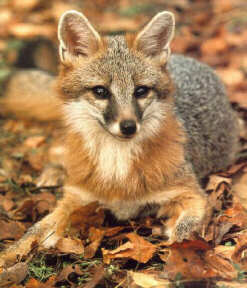
 |
| While it closely resembles the red fox, the grey fox is a more distant relative than either of it´s other three North American relatives. |
Because it is less common than the red fox, less valuable commercially than the arctic, and not the subject of major conservation programs like the swift, somewhat less information is availlable about the grey fox. Though it is quite similar in appearance to the red fox, the grey fox is actually less closely related to it than either the arctic or the swift foxes. The basic body structure closely resembles the red fox´s, but at 80-113cm in length, is slightly smaller.
The fur exhibits a salt & pepper grey colour, gradually turning to rust towards the belly. The belly and chin are white. A black stripe runs down the dorsal surface of its tail, which can be differentiated from that of the red fox´s by the notable abscence of a white tip or tag.
The grey fox is the only North American canid capable of climbing trees, which it scales in a catlike manner. Study of the grey fox´s anatomy suggest that it´s climbing ability is improved by the rotational mobility of its forelegs, which is greater than that of other canids. The tracks of the grey fox are also smaller and well defined than those of the red, due to there being less hair around the pads.
| Table of Contents |